For many bikepackers summer means one thing: it’s time to hit the most mountainous trails. The peak months of summer and early fall are a special time for outdoor adventures, a narrow window when the world’s most spectacular terrain can be accessed under (mostly) sunny skies and without snow gear.
These mountain bikepacking routes are accessible and at their best starting around mid-July, though a couple may be accessible earlier and a high snow year could push ideal timing into August. They’ll usually be rideable through September, maybe even into early October if the first snows arrive late.
It’s always smart to check snow levels and keep an eye on the forecast when bikepacking in the mountains, but it’s especially essential when dabbling in shoulder season on routes like these.
I usually write from first-person experience on this site, but I’ve personally pedaled only half of these routes (the rest are on my ever-growing wishlist). Most are here in the United States, the country I know best, but I’ve also included a handful of destination routes abroad.
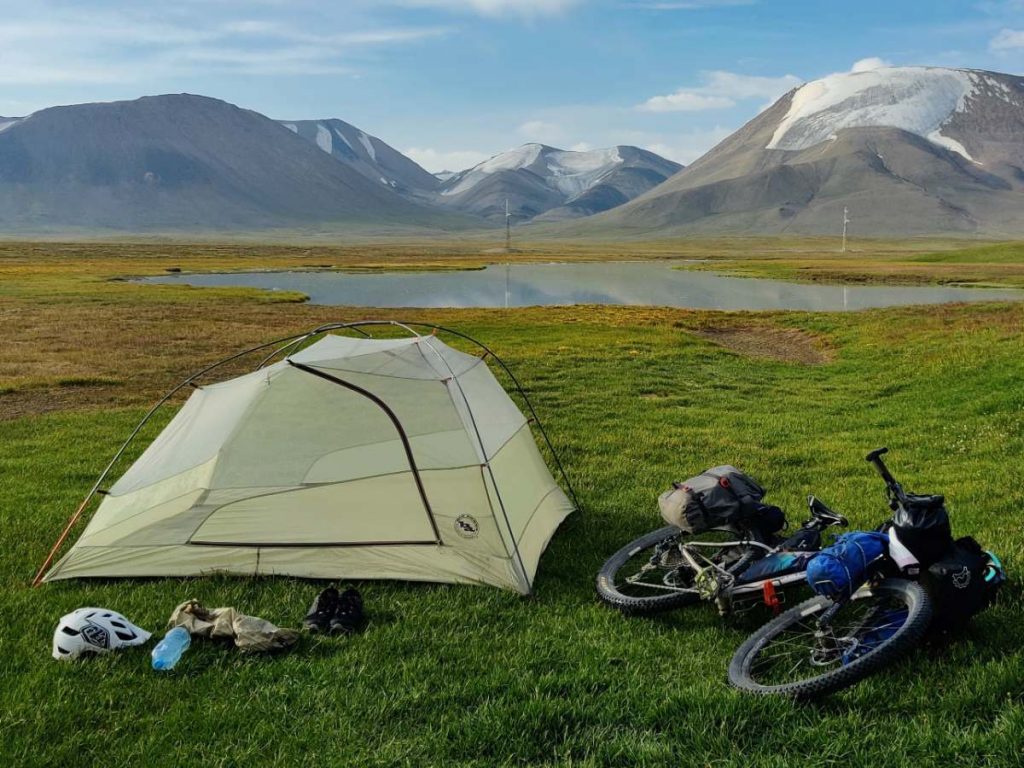
Scenic mountain campsite above 12,000 feet in Kyrgyzstan
Mountain Bikepacking Routes in the U.S.
Here in the United States we’re lucky to have some truly world-class mountain ranges. The Rockies dominate the continental topography and this list, and they are by far the easiest place to spend a few days above 10,000 feet on a bike. The Sierra Nevada, just as beautiful but less accessible to bikes, offers at least one classic mountain bikepacking route. The Cascades of the Pacific Northwest are lower in average elevation but not to be underestimated in their beauty and ruggedness.
With apologies to the East Coast I’ve focused on the Rockies westward here. The Appalachian range is formidable, but it simply doesn’t reach the same heights as the others and I’m less familiar with it personally.
Colorado Trail
Distance: 539 miles
High point: 13,270 feet
Style: technical singletrack
Learn More: bikepacking.com and Colorado Trail Foundation
I can’t resist starting with arguably the most iconic high alpine bikepacking route in America: the breathtaking (literally) Colorado Trail. We can’t all have the skills and stamina to bikepack the CT from Denver to Durango (or vice versa), but we can all be inspired by it!
With a lung-busting high point of over 13,000 feet elevation, 55% singletrack trail, and a network of historic mountain towns for resupply, this is backcountry MTB bikepacking at its finest.
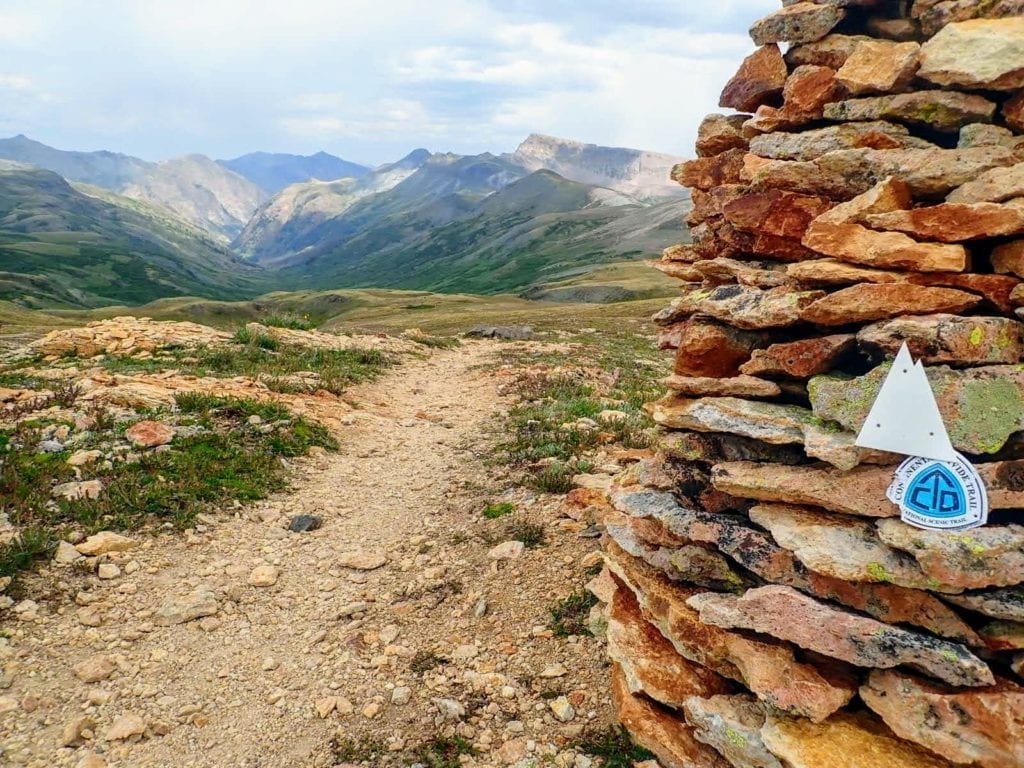
The Colorado Trail, also a famous hiking route, overlaps with the Continental Divide Trail in many places.
Vapor Trail (Colorado)
Distance: 108 miles
High point: 12,582 feet
Style: technical singletrack and nontechnical dirt roads
Learn More: bikepacking.com
If the Colorado Trail feels like a bit much, the Vapor Trail offers a taste of high Rocky Mountain bikepacking in just a few days. The 3-4 day loop, starting and finishing in the adventure town of Salida, makes for simple logistics and guaranteed post-ride beer and burgers.
Colorado’s mountain railroad history is on display throughout, and riders will surely appreciate the gradual slope of two major climbs following old railway grades. Don’t expect an easy ride though; the route is 40% singletrack, never dips below 7000 feet elevation, and spends nearly 40% of its mileage above 10,000 feet.
Colorado 14ers Loop
Distance: 193 miles
High point: 13,185 feet
Style: technical singletrack
Learn More: Bikepacking Roots
Another option for those who can’t get enough of the high alpine riding in this region, the Colorado 14ers Loop overlaps a short stretch of the Colorado Trail and offers access to several of Colorado’s highest peaks.
Of course you’ll have to leave the loop to hike or bike them if you want to tag the summits, or you can content yourself with simply enjoying the views from the main loop. Like the nearby Vapor Trail this loop offers consistent mountain riding throughout; the low point is over 7000 feet.
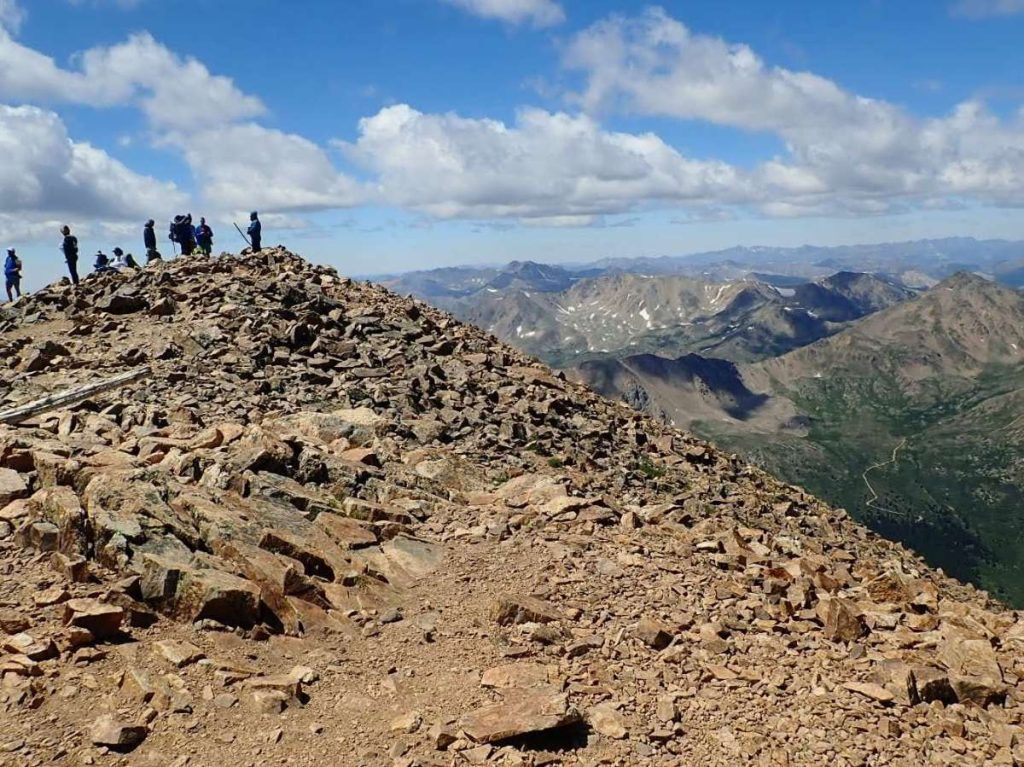
The summit of Mt. Elbert, tallest mountain in Colorado and just a little 4000 vertical foot out-and-back from the main 14ers Loop. (Full disclosure: I got here on foot, which is much easier than with a bike.)
Great Divide: Southern Colorado & Northern New Mexico
Distance: 452 miles (Silverthorne to Abiquiu)
High point: 11,958 feet
Style: nontechnical dirt and gravel
Learn more: Adventure Cycling
If the Colorado Rockies strike your fancy but your singletrack skills aren’t up to snuff, consider a section ride of the Great Divide Mountain Bike Route between Silverthorne, CO (near Breckenridge) and Abiquiu, NM.
The GDMBR, probably the most famous long-distance bikepacking route in the world, parallels the continental divide on mostly gravel and dirt roads. Mountains are a focus throughout, but the section through Colorado offers arguably the longest and most classic stretch of alpine scenery (the Canadian section being a close second).
The section through southern Colorado takes riders over the high point of the entire route, Indiana Pass, just shy of 12,000 feet. There’s plenty of climbing en route to other dramatic passes like Marshall and Boreas, but though the ascents are long the gradients are often consistent and rideable. The southernmost stretch of this section, in northern New Mexico, showcases an unexpected side of the state and offers much quieter backroads than Colorado.
The GDMBR is quintessentially point to point, but the TransRockies Connector and other Intermountain Connectors from Bikepacking Roots offer the possibility of a large loop including part of the Western Wildlands Route (more on that below).
My experience: Bikepacking the GDMBR: Colorado and The Great Divide: Essential Q&A
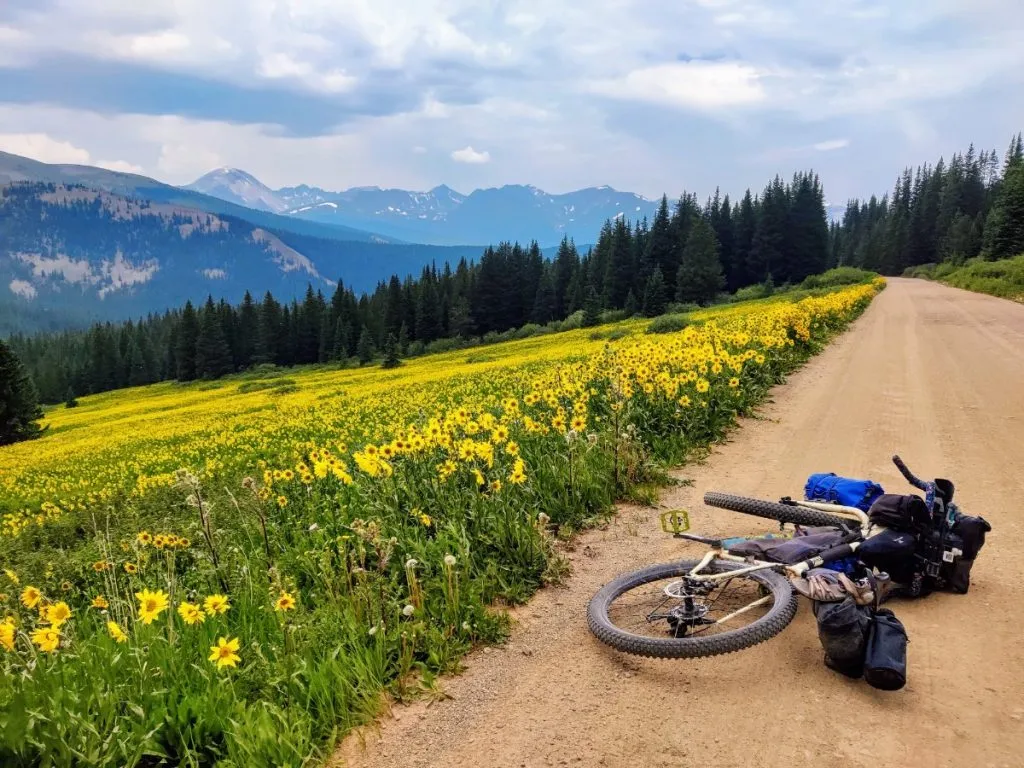
Near Boreas Pass, elevation 11,493 feet, on the Colorado section of the Great Divide.
Mount St. Helens Epic Weekender (Washington)
Distance: 79 miles
High point: 5,291 feet
Style: technical singletrack
Learn More: bikepacking.com
Though the volcanic Cascade mountains of the Pacific Northwest aren’t as tall as the Rockies, they’re not to be underestimated! The region’s rugged topography and lower snowline put this route squarely in summer bikepacking territory despite its unimpressive high point of 5,300 feet.
Mount St. Helens’ last major eruption occurred in1980, very recent by geologic standards, so riders experience a unique volcanic landscape alongside more typical forested trails. At 58% singletrack with plenty of steep climbing, this route isn’t for the faint of heart (or legs), but it would make an excellent 2 -3 day bikepacking trip for strong riders.
Tahoe Twirl (California, Nevada)
Distance: 187 miles
High point: 9600 feet
Style: nontechnical dirt and gravel with substantial amount of singletrack
Learn More: bikepacking.com
California’s stunning Sierra Nevada range is every bit as spectacular as the Rockies, but much of the highest and most scenic land lies in national parks and wilderness areas where bikes are not allowed. The Tahoe Twirl loop around Lake Tahoe, in the northern part of the range, may be the closest thing we have to an iconic Sierra bikepacking route.
This circumnavigation offers easy logistics, frequently fair summer weather, and an engaging blend of singletrack and dirt roads around one of the most famous lakes in the world.
My experience: Bones to Blue Bikepacking Race
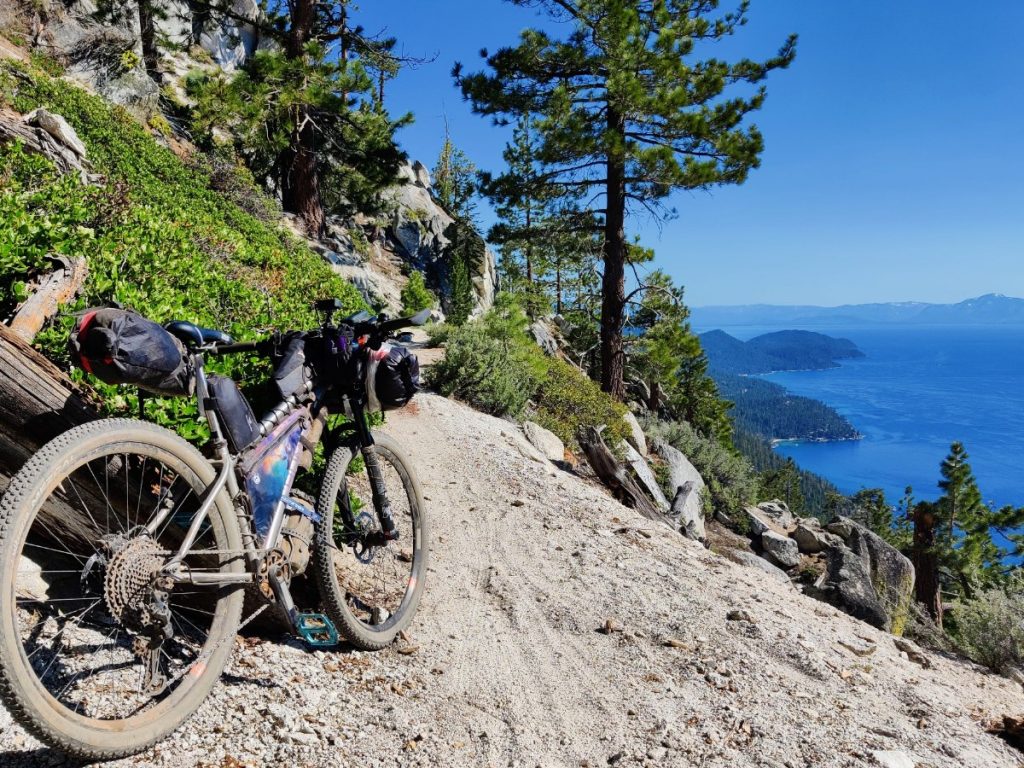
The famous Flume Trail offers some of the best lake views on the Tahoe Twirl.
Read More: California Bikepacking: Route Ideas in Every Region
Western Wildlands: Utah’s High Plateaus
Distance: 124 miles (Soldier Summit to Salina)
High point: 10,897 feet
Style: nontechnical dirt and gravel
Learn More: Bikepacking Roots
The word “plateau” may not spring to mind when you think of high elevation bikepacking, but this ride spends quality time — about 65 continuous miles of it — above 9,000 feet. Traversing the spine of the Wasatch Plateau, the WWR follows the famous ridgeline 4×4 road “Skyline Drive” up out of the aspen stands and across a windswept rolling landscape.
The highest chunk ends with an epic 5000 foot descent (if you go southbound!) to Salina, but riders with more time can ascend again to the Aquarius Plateau and even continue to the lower desert landscapes of southern Utah and beyond.
The full Western Wildlands is a border-to-border epic that takes most riders several months to complete, but this Utah section makes a fantastic shorter summer or early fall ride. Link it up with the Great Divide Mountain Bike Route (see above) via the Intermountain Connectors for a double dose of scenic high-elevation bikepacking.
My experience: WWR Section Ride: Utah
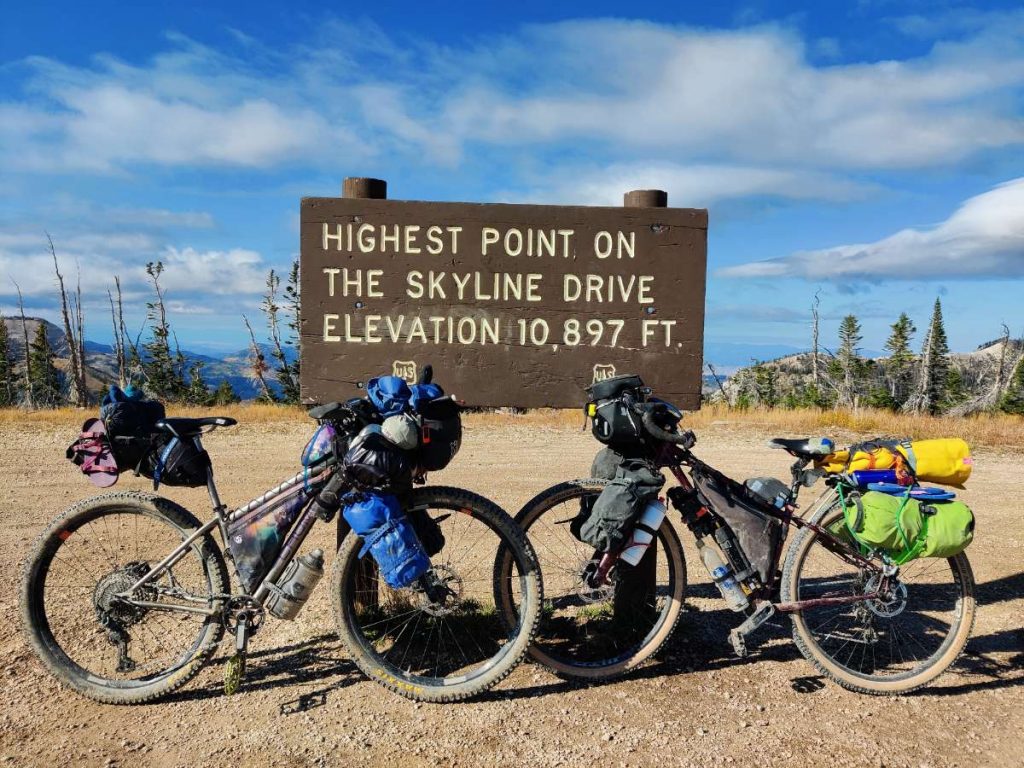
Read more: Utah Bikepacking Routes for All Levels
International Mountain Bikepacking Routes
For those who relish a particular blend of physical challenge and mental stimulation, bikepacking abroad is an adventure like no other. Earth is home to many impressive mountain ranges, and many bikepacking routes are still waiting to be pieced together. Here’s a small selection of diverse routes in other countries focused on big mountain riding in the northern hemisphere’s summer months.
Tian Shan Traverse (Kyrgyzstan)
Distance: 613 miles
High point: 12,600 feet
Style: nontechnical dirt and gravel
Learn More: bikepacking.com
If there’s such a thing as the Rockies of Central Asia, Kyrgyzstan’s Tian Shan Mountains would be it. This beast of a ride traverses some of Central Asia’s most stunning alpine scenery as it follows long river valleys through remote high pastureland and over even higher passes. Though settled sparsely during the summer by nomadic families in yurts, the region maintains a feeling of wildness that’s sure to satisfy lovers of big mountains and remote places.
My experience: Tian Shan Traverse Ride Report
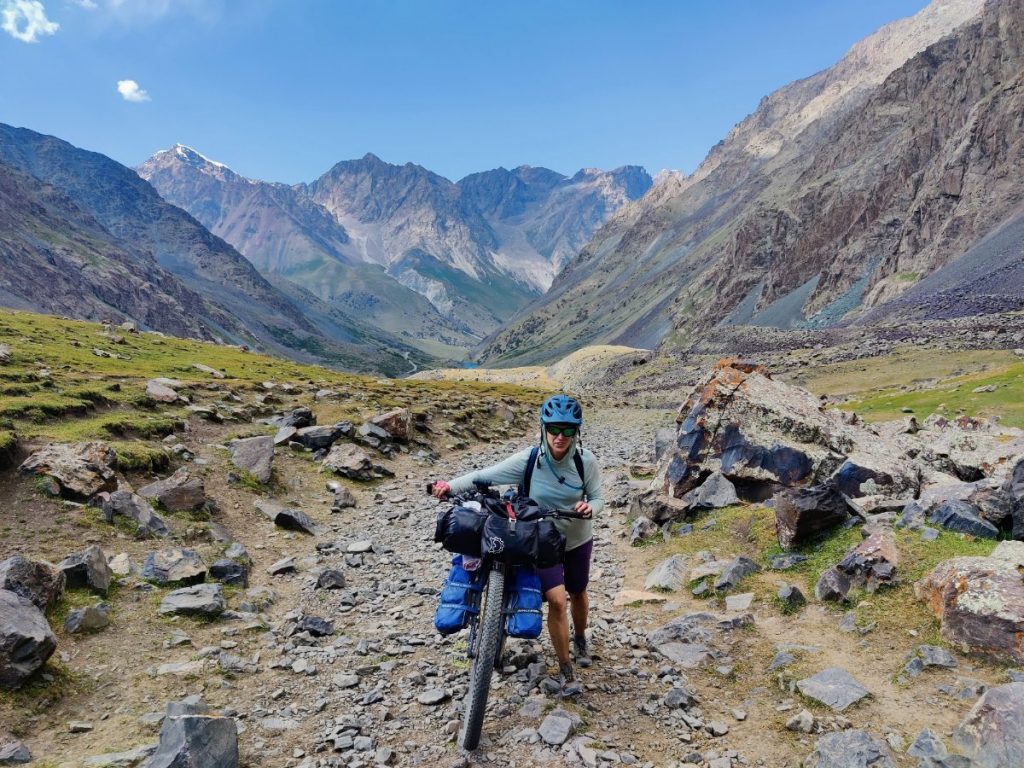
This climb, near the beginning of the Tian Shan Traverse, is as challenging as it is gorgeous.
Best of the South Chilcotin Mountains (BC, Canada)
Distance: 75 miles
High point: 7,300 feet
Style: technical singletrack
Learn More: bikepacking.com
No discussion of mountain bikepacking routes is complete without a mention of Canada’s British Columbia. The Canadian Rockies, the northernmost extension of the Rocky mountains mentioned many times already, are home to some staggeringly beautiful mountain scenery and a distinctly different feel than their southern counterparts. The bikepacking route possibilities up here are probably endless, but this little loop with 65% singletrack, much of it flowy and fast, looks to be as good as it gets.
Trans-Dolomiti (Italy)
Distance: 163 miles
High point: 7,945 feet
Style: nontechnical dirt and gravel
Learn More: bikepacking.com
For a quintessentially European take on mountain bikepacking, it’s hard to do better than this scenic loop in the Italian Dolomites. Between steep climbs on rugged roads riders can sip espresso, eat Italian food, and even sleep in refugios (book ahead) for a surprisingly civilized alpine adventure. Though the region’s WWI military history is dark, today it’s an idyllic mountain playground for bikepackers, hikers, and other lovers of big mountain scenery.
Mountain Bikepacking Tips
If you’ve never bikepacked in big mountains before or need a refresher, here are some things you need to know.
Electrical storms: High exposed places and electrical storms aren’t a good combination for bikepackers, or anyone else who doesn’t want to be struck by lightning. Some mountain areas have a monsoon season during the summer that reliably delivers thunderstorms most afternoons. When riding in big mountains you’ll want to start early in the day, keep an eye on the clouds (puffs that grow taller than they are wide suggest building thunderstorms), and be over any mandatory high points by early afternoon. If in doubt hunker down in a stand of trees or, above treeline, a low point in the topography until the storm passes.
Weather: Lightning isn’t the only weather-related challenge in the mountains. Even during summer it’s totally possible to find yourself being pelted by hail or dusted with snow at high elevations. Nights can easily dip below freezing and days can be windy. You’ll want a reliable bikepacking shelter and sleep system and a thoughtful layered clothing system that can weather the elements. Some routes also have the issue of “Death Mud” to consider during periods of heavy rain, usually on dirt roads in areas with clay-rich soil.
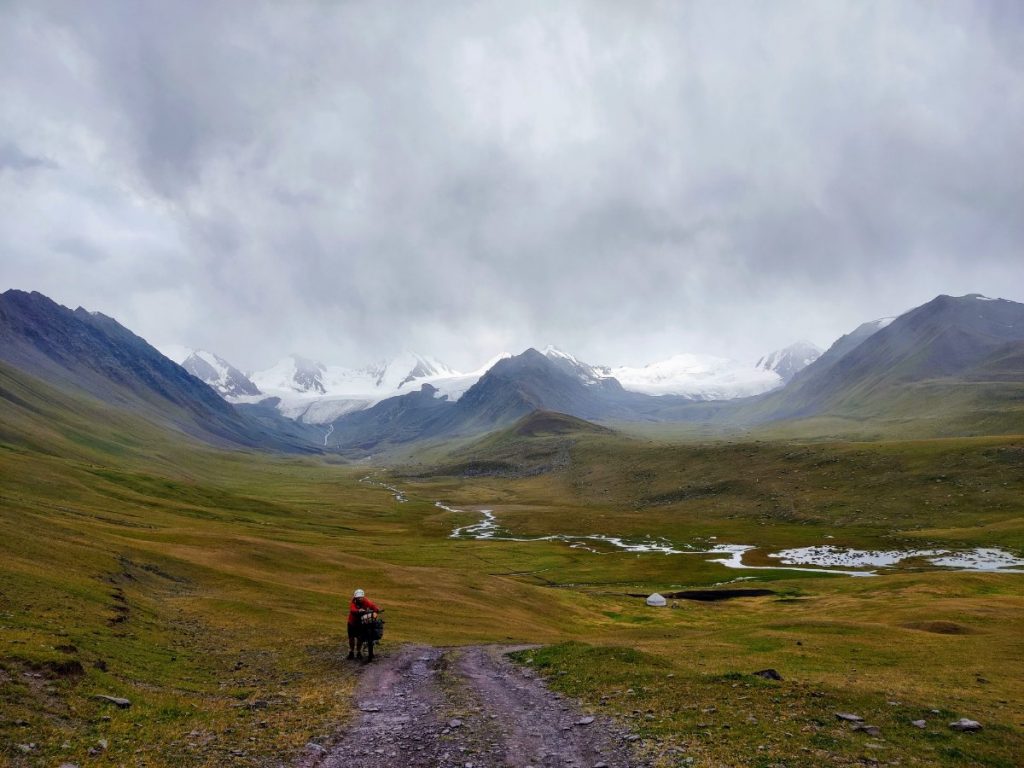
Weather is always a factor when bikepacking in the mountains.
Timing: No route on this list should be attempted outside of summer or early fall. June will work for a few of them, especially in low snow years, but mid-July is a safer bet especially for the Rockies. August and early-to-mid September are excellent times to ride these routes, and it may be possible to push into October if the first storms hold off. Always check snowpack levels and weather forecasts, especially if dabbling in shoulder seasons.
Altitude: Most people will feel some normal effects of high altitude — shortness of breath, a bit of nausea and headache, trouble sleeping well — above 9000 or 10,000 feet. For some unlucky folks the effects start lower, around 7000 or 8000 feet. The best way to feel good at high elevation is to ascend slowly, giving your body a couple days to acclimate. It’s also essential to drink plenty of water — more than you usually would — and if possible arrange to “ride high and camp low,” covering high sections in a single day and choosing lower areas to sleep. If you start feeling truly unwell it’s safest to descend to lower elevation right away.
Climbing: Most mountain bikepacking routes feature big climbs; there’s just no way around it. Combine all that elevation gain with the challenges of high altitude and you’ll probably move slower than you expect. Get a bit of training in your legs beforehand, pack light, and remember hike-a-bike is your friend.

Hike-a-bike is often part of the mountain bikepacking experience. Learn to love it!
More Bikepacking Resources
If you enjoyed this post, you might also like these:
Or visit the bikepacking section for lots more!
About the Author
Hi there, I’m Alissa, founder of Exploring Wild. I’ve traveled over 20,000 miles by bike and still can’t stop planning my next ride (and helping you plan yours). Pavement and panniers or singletrack and seat bag, I love it all. On my bike I feel free. Learn more about me here.
Bike resources in your inbox?
There’s more where this came from! Sign up here for occasional emails full of inspiration and information about bikepacking and bicycle touring.
The post 10 Alpine Bikepacking Routes for Your Summer Wishlist appeared first on Exploring Wild.
https://exploringwild.com/mountain-bikepacking-routes-for-summer/?utm_source=rss&utm_medium=rss&utm_campaign=mountain-bikepacking-routes-for-summer
 CampingSurvivalistHuntingFishingExploringHikingPrivacy PolicyTerms And Conditions
CampingSurvivalistHuntingFishingExploringHikingPrivacy PolicyTerms And Conditions
